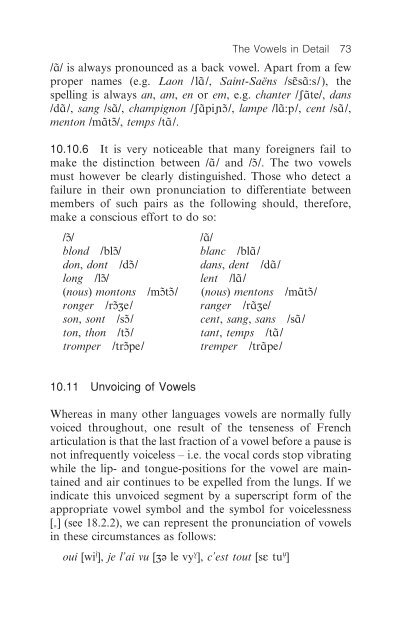An Introduction to French Pronunciation
An Introduction to French Pronunciation
An Introduction to French Pronunciation
Create successful ePaper yourself
Turn your PDF publications into a flip-book with our unique Google optimized e-Paper software.
The Vowels in Detail 73<br />
/e/ is always pronounced as a back vowel. Apart from a few<br />
proper names (e.g. Laon /le/, Saint-Saëns /shse:s/), the<br />
spelling is always an, am, en or em, e.g. chanter /ʃete/, dans<br />
/de/, sang /se/, champignon /ʃepif/, lampe /le:p/, cent /se/,<br />
men<strong>to</strong>n /metf/, temps /te/.<br />
10.10.6 It is very noticeable that many foreigners fail <strong>to</strong><br />
make the distinction between /e/ and /f/. The two vowels<br />
must however be clearly distinguished. Those who detect a<br />
failure in their own pronunciation <strong>to</strong> differentiate between<br />
members of such pairs as the following should, therefore,<br />
make a conscious effort <strong>to</strong> do so:<br />
/f/ /e/<br />
blond /blf/ blanc /ble/<br />
don, dont /df/ dans, dent /de/<br />
long /lf/ lent /le/<br />
(nous) mon<strong>to</strong>ns /mftf/ (nous) men<strong>to</strong>ns /metf/<br />
ronger /rfʒe/ ranger /reʒe/<br />
son, sont /sf/ cent, sang, sans /se/<br />
<strong>to</strong>n, thon /tf/ tant, temps /te/<br />
tromper /trfpe/ tremper /trepe/<br />
10.11 Unvoicing of Vowels<br />
Whereas in many other languages vowels are normally fully<br />
voiced throughout, one result of the tenseness of <strong>French</strong><br />
articulation is that the last fraction of a vowel before a pause is<br />
not infrequently voiceless – i.e. the vocal cords s<strong>to</strong>p vibrating<br />
while the lip- and <strong>to</strong>ngue-positions for the vowel are maintained<br />
and air continues <strong>to</strong> be expelled from the lungs. If we<br />
indicate this unvoiced segment by a superscript form of the<br />
appropriate vowel symbol and the symbol for voicelessness<br />
[ ˚ ] (see 18.2.2), we can represent the pronunciation of vowels<br />
in these circumstances as follows:<br />
oui [wi q ], je l’ai vu [ʒc le vy z ], c’est <strong>to</strong>ut [sε tu w ]












